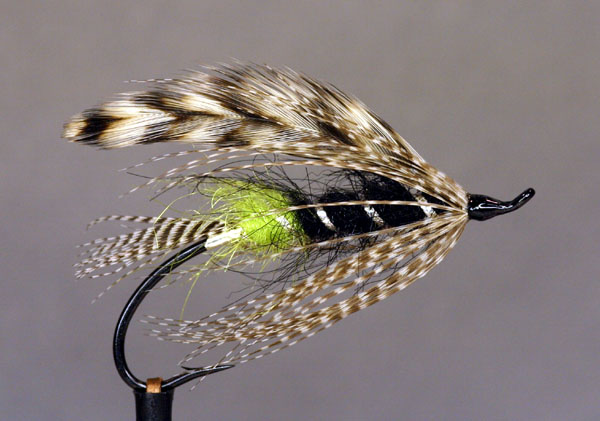
On The Fly
September 2010
"Fly tying is a school from which we never graduate"
TYING NEWS
The Southern Oregon Fly Tyers invite you to attend their meetings the second Tuesday
of each month. The next meeting is September 14, 2010. The meetings start at 6:00 PM, at the Madrone Hill
Mobile Home Park community building near Gold Hill. Bring a friend, come early so you don't miss anything,
and stay late. Tyers need not be experienced, and those with all levels of skill are welcome. Each meeting
a member is encouraged to demonstrate a new or different skill, from simple to difficult. For more
information, call Dan Kellogg at 773-4724.
DIRECTIONS: Take Gold Hill Exit #40, off of I-5 and go west, toward Jacksonville, 1.3
miles, until you reach the brick entrance way to the Madrone Hill Mobile Home Park on the right. You’ll
pass a golf course parking lot on Your left shortly after leaving the freeway. After you turn right into the
mobile home park, proceed to the community building which is located about 100 yards ahead on the left. The
address is 8401 Old Stage Rd. Please park your vehicle on the bare dirt in the parking lot to avoid the
wooden septic covers in the grass.
PATTERN OF THE MONTH - Green Butt Silver Hilton

Hook: Daiichi 2441, std. salmon/steelhead, size 10-4
Thread: 6-0 black.
Tag: Flat silver tinsel.
Tail: Teal flank fibers.
Butt: Fluorescent green nylon-stretch or floss.
Rib: Oval silver tinsel.
Body: Black dubbing, wool, or poly yarn
Hackle: Teal flank feather.
Wing: Paired grizzly hackle tips, curved away.
Head: Black thread.
Tying Instructions
Step 1 Mash the barb and mount the hook in the vise.
Step 2: Start the thread two eye widths behind the eye and lay down an even thread base to just above the
hook point.
Step 3: Tie in the flat tinsel and wrap rearward to just above the hook barb, reverse direction and wrap
forward back to the tie-in position. Tie off and trim.
Step 4: Select a small bunch of teal flank fibers, measure them to be about 1/2 the shank length, and tie
them on top of the shank just above the hook point. Do not trim the butts, tie them down along the top of
the shank up to the original tie-in point with spiral wraps.
Step 5: Tie in the nylon stretch, bind it down rearward the length of the shank to the base of the tail.
Wind it forward in touching wraps forming a butt twice a wide as the tag. Tie off and trim.
Step 6: Tie in the oval tinsel at the front, binding it down the length of the shank to the base of the
butt, leaving it hang to the back for use later as the rib.
Step 7: Dub the thread or tie in the wool or poly and wind forward forming a even body up to the original
tie-in spot. Tie off and trim excess.
Step 8: Wind the oval tinsel forward in 5 even wraps to the front of the body. Tie off and trim.
Step 9: Select a Teal flank feather with barbs as long as the body and tie in by the tip. Fold the barbs
back, make about 3 or 4 turns stroking them back over the body on every half turn, then tie back on the
stems until the barbs sweep back low over the shank. Tie off and trim.
Step 10: Select two round-tipped grizzly hackle feathers of equal size and lay them back to back with the
tips splaying away from each other. Measure to length so the tips reach half way down the tail, strip the
stems, and tie them in on top of the shank in front of the body. Keep them as low as possible over the body.
Step 11: Form a nice small tapered thread head, whip finish, cement, and admire your work
How do you double the odds in your favor against the illusive summer steelhead? Combine
the two most productive Rogue River flies of all time, the Green Butt Skunk, and the Silver Hilton. That's
what the originator, Dave McNeese, did back in the seventies and it has frequently out produced the
originals, especially when the sun goes off the water. I think he came up with a more natural pattern,
great when fish are starting to get a little spooky. Maybe it should be called the Silver Hilton, Green
Butt, Spey, Low-water.
TYING TIPS
Again this month give yourself plenty of room for wing, over-wing and head on your
initial tie-in position. You can't hide start and stop points on this one due to the slim body profile.
Butts and tags should be tied in the full length of the body. Keep materials somewhat sparse, especially on
smaller hook sizes. For the body many materials can be used as long as it stays slim and trim. To achieve a
small head, keep your thread wraps to a minimum and place one material right next to the following material.
Try not to stack them. Bumps look bad but could also hold hackles and wings at a too severe angle for low
water styles. If you have tied either pattern, you can easily master this one. So tie some up, give them a
test flight and let me know how you do.
Tie One On,
Dan Kellogg (you can contact me at FLYGUY@EZNORTHWEST.COM)